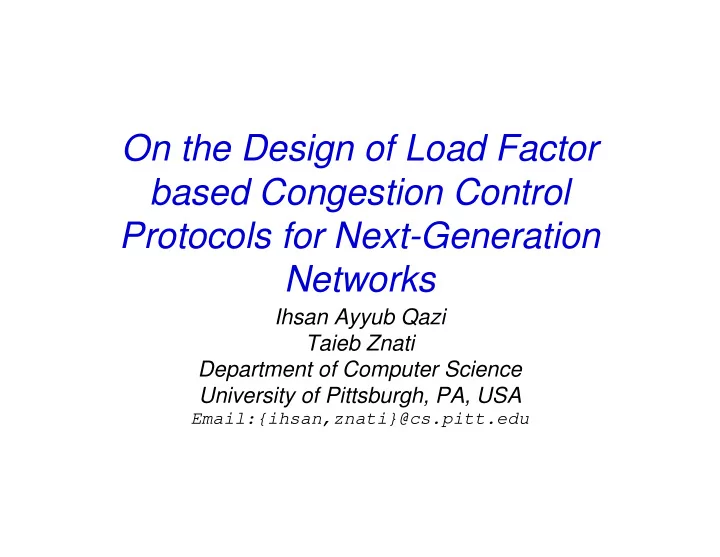

On the Design of Load Factor based Congestion Control Protocols for Next-Generation Networks Ihsan Ayyub Qazi Taieb Znati Department of Computer Science University of Pittsburgh, PA, USA Email:{ihsan,znati}@cs.pitt.edu
Agenda Motivation Existing Solutions Goals of our Work Insights from Analysis Design of our Protocol Conclusion {ihsan,znati}@cs.pitt.edu 2
Motivation Trends in Technology o increases in link capacities (e.g. 40+ Gbps links) and delay (e.g. satellite, wireless WANs) o proliferation of real-time applications (e.g. Skype, iTunes) Issues with TCP o reacts adversely to increases in capacity and/or delay o introduces large delay and throughput variations o may lead to the situation where most Internet traffic does not use TCP {ihsan,znati}@cs.pitt.edu 3
TCP: Signal of Congestion + Window Update Policies Packet loss (e.g., used by TCP Reno, NewReno, SACK etc) o Binary + implicit signal of congestion • Self-induced packet losses • Large average queuing delay Window Update Policies o Conservative increase (AI: 1 pkt/RTT) • takes a long time to acquire bandwidth on high BDP paths o Aggressive decrease (MD: ½ after packet loss) • induces large variations in delay and throughput {ihsan,znati}@cs.pitt.edu 4
Existing Solutions End-to-End (E2E) schemes with Implicit Feedback e.g. TCP o have fundamental performance limitations Network-based schemes e.g. XCP o can achieve optimal performance o high per-packet overhead may constraint router speed o high deployment barrier E2E schemes with Explicit Feedback e.g. TCP+AQM/ECN, VCP o perform better than E2E schemes (implicit feedback) o involves changes at the end-hosts with incremental support from the routers {ihsan,znati}@cs.pitt.edu 5
E2E schemes with Explicit Feedback VCP [Xia, SIGCOMM 05] o Uses two bits for the feedback • Slow convergence to efficiency ( MI Factor = 1.0625 ) – Makes short flows to last longer • Unfairness in the presence of diverse RTT flows • Reduced responsiveness to congestion Load Code overload (11) VCP Control 1.0 high -load (10) 0.8 MD low -load (01) 0.0 AI MI ACK 10 10 Sender Receiver {ihsan,znati}@cs.pitt.edu 6
Goals of our Work Analyze the tradeoff between increasing the amount of feedback information and the resulting performance improvement Analyze window increase/decrease policies for achieving efficiency and fairness on high BDP paths, while keeping low queues and negligible packet drop rates {ihsan,znati}@cs.pitt.edu 7
Insights from Analysis Convergence to efficient bandwidth allocation o 3-bit feedback sufficient for near-optimal performance o performance follows the law of diminishing returns Convergence to fair bandwidth allocation o using multiple levels (e.g. 8-levels) for the multiplicative decrease policy enables the protocol to adjust its • convergence rate to fairness, rate variations and responsiveness based on the degree of congestion at the bottleneck. {ihsan,znati}@cs.pitt.edu 8
Convergence to Efficiency Key Observation o increasing the feedback information beyond 3 bits improves only a small part of the overall time Helps flows to finish quicker {ihsan,znati}@cs.pitt.edu 9
Convergence to Efficiency Key Observation o increasing the feedback information beyond 3 bits improves only a small part of the overall time Helps flows to finish quicker {ihsan,znati}@cs.pitt.edu 10
Convergence to Efficiency Pareto Distributed File Sizes Average File Size: 30KB Link Capacity: 10Mbps RTT: 200ms Key Observation o increasing the feedback information beyond 3 bits improves only a small part of the overall time Helps flows to finish quicker {ihsan,znati}@cs.pitt.edu 11
Convergence to Fairness In AIMD-like protocols, the following are intrinsically tied o convergence rate to fairness (CF) o flow rate variations (RV) o responsiveness to congestion (RC) High CF high RV Small FV low RC and CF Key Observation o single value of beta (MD) not suitable o optimize for the target situations • small beta when new flows arrive • high beta in steady-state {ihsan,znati}@cs.pitt.edu 12
MLCP: Control laws Parameters Symbol load 120% Multiplicative Decrease 1111 … ... 101% Inversely Proportional Increase 1001 100% 1000 95% Additive Increase 0111 80% 0110 64% Multiplicative Increase 0100 48% 0011 32% 0010 16% 0001 0% {ihsan,znati}@cs.pitt.edu 13
Control Laws Fairness in the presence of diverse RTT flows MI and AI parameters are scaled to handle RTT heterogeneity {ihsan,znati}@cs.pitt.edu 14
Control Laws Fairness in the presence of diverse RTT flows MI and AI parameters are scaled to handle RTT heterogeneity {ihsan,znati}@cs.pitt.edu 15
Evaluation Extensive ns-2 simulations 200Mbps, 80ms, 10 forward flows and 10 reverse flows Dst 1 Src 1 forward traffic Dst 2 Src 2 ……. ……. reverse traffic Src N Dst N {ihsan,znati}@cs.pitt.edu 16
MLCP: Achieves high efficiency {ihsan,znati}@cs.pitt.edu 17
MLCP: Minimizes queuing delay and loss rate {ihsan,znati}@cs.pitt.edu 18
MLCP: Fairness + Smooth rate variations {ihsan,znati}@cs.pitt.edu 19
Ongoing and Future Work MLCP requires 4-bits of congestion-related feedback, however, only two bits are allocated for ECN in the IP header We are analyzing a 1-bit packet marking scheme called Adaptive Deterministic Packet Marking (ADPM) to convey high resolution congestion price estimates 1 1 Lachlan L. H. Andrew, Stephen V. Hanly, Sammy Chan and Tony Cui, “Adaptive Deterministic Packet Marking,” IEEE Comm. Letters , 10(11):790-792, Nov 2006. {ihsan,znati}@cs.pitt.edu 20
Conclusion We analyzed the tradeoff between increasing the feedback information and the resulting performance improvement Based on the insights, we designed and implemented a low-complexity protocol, MLCP MLCP o Achieves high utilization on high BDP paths, maintains low queues and negligible packet loss rate o Helps flows to finish quicker than 2-bit schemes such as VCP o Ensures fairness in the presence of diverse RTT flows o Enables the sources to adjust convergence to fairness , rate variations and robustness based on the degree of congestion at the bottleneck {ihsan,znati}@cs.pitt.edu 21
Thank You! {ihsan,znati}@cs.pitt.edu 22
Recommend
More recommend